2.58 kW Narrow Linewidth Fiber Laser Based on a Compact Structure with a Chirped and Tilted Fiber Bragg Grating for Raman Suppression
Abstract
:1. Introduction
2. Experimental Setup
3. Results and Discussion
3.1. Laser Performance with Amplifier Configuration 1
3.2. Laser Performance with Amplifier Configuration 2
4. Conclusions
Author Contributions
Funding
Institutional Review Board Statement
Informed Consent Statement
Data Availability Statement
Conflicts of Interest
References
- Zervas, M.N.; Codemard, C.A. High power fiber lasers: A review. IEEE J. Sel. Top. Quantum Electron. 2014, 20, 219–241. [Google Scholar] [CrossRef]
- Stiles, E. New developments in IPG fiber laser technology. In Proceedings of the 5th International Workshop on Fiber Lasers, Dresden, Germany, 30 September 2009. [Google Scholar]
- Shiner, B. The Impact of Fiber Laser Technology on the World Wide Material Processing Market; CLEO: Applications and Technology: San Jose, CA, USA, 2013; AF2J.1. [Google Scholar]
- Shcherbakov, E.A.; Fomin, V.V.; Abramov, A.A.; Ferin, A.A.; Mochalov, D.V.; Gapontsev, V.P. Industrial grade 100 kW power CW fiber laser. In Advanced Solid-State Lasers Congress; Huber, G., Moulton, P., Eds.; OSA Technical Digest (online); Optical Society of America: Paris, France, 2013; ATh4A. 2. [Google Scholar]
- Wirth, C.; Schmidt, O.; Tsybin, I.; Schreiber, T.; Eberhardt, R.; Limpert, J.; Tünnermann, A.; Ludewigt, K.; Gowin, M.; Ten Have, E.; et al. High average power spectral beam combining of four fiber amplifiers to 8.2 kW. Opt. Lett. 2011, 36, 3118–3120. [Google Scholar] [CrossRef] [PubMed]
- Zheng, Y.; Yang, Y.; Wang, J.; Hu, M.; Liu, G.; Zhao, X.; Chen, X.; Liu, K.; Zhao, C.; He, B.; et al. 10.8 kW spectral beam combination of eight all-fiber super-fluorescent sources and their dispersion compensation. Opt. Express 2016, 24, 12063–12071. [Google Scholar] [CrossRef] [PubMed]
- Yu, C.; Shatrovoy, O.; Fan, T.; Taunay, T. Diode-pumped narrow linewidth multi-kilowatt metalized Yb fiber amplifier. Opt. Lett. 2016, 41, 5202–5205. [Google Scholar] [CrossRef]
- Ma, P.; Tao, R.; Su, R.; Wang, X.; Zhou, P.; Liu, Z. 1.89 kW all-fiberized and polarization-maintained amplifiers with narrow linewidth and near-diffraction-limited beam quality. Opt. Express 2016, 24, 4187–4195. [Google Scholar] [CrossRef]
- Su, R.; Liu, Y.; Yang, B.; Ma, P.; Wang, X.; Zhou, P.; Xu, X. Active polarization control of a 1.43 kW narrow linewidth fiber amplifier based on spgd algorithm. J. Opt. 2017, 19, 045802. [Google Scholar] [CrossRef]
- Li, T.; Zha, C.; Sun, Y.; Ma, Y.; Ke, W.; Peng, W. 3.5 kW bidirectionally pumped narrow-linewidth fiber amplifier seeded by white-noise-source phase-modulated laser. Laser Phys. 2018, 28, 105101. [Google Scholar] [CrossRef]
- Huang, Z.; Liang, X.; Li, C.; Lin, H.; Li, Q.; Wang, J.; Jing, F. Spectral broadening in high-power yb-doped fiber lasers employing narrow-linewidth multilongitudinal-mode oscillators. Appl.Opt. 2016, 55, 297–302. [Google Scholar] [CrossRef]
- Qi, Y.; Yang, Y.; Shen, H.; He, B.; Zhou, J. 2.7 kW CW Narrow Linewidth Yb-Doped All-Fiber Amplifiers for Beam Combining Application. Advanced Solid-State Lasers: ATu3A.1; Optical Society of America: Paris, France, 2017. [Google Scholar] [CrossRef]
- Su, R.; Tao, R.; Wang, X.; Zhang, H.; Ma, P.; Zhou, P.; Xu, X. 2.43 kW narrow linewidth linearly polarized all-fiber amplifier based on mode instability suppression. Laser Phys. Lett. 2017, 14, 085102. [Google Scholar] [CrossRef]
- Ma, P.; Xiao, H.; Meng, D.; Liu, W.; Tao, R. High power all-fiberized and narrow-bandwidth MOPA system by tandem pumping strategy for thermally induced mode instability suppression. High Power Laser Sci. Eng. 2018, 6, e57. [Google Scholar] [CrossRef] [Green Version]
- Lin, H.; Tao, R.; Li, C.; Wang, B.; Guo, C.; Shu, Q.; Zhao, P.; Xu, L.; Wang, J.; Jing, F.; et al. 3.7 kW monolithic narrow linewidth single mode fiber laser through simultaneously suppressing nonlinear effects and mode instability. Opt. Express 2019, 27, 9716–9724. [Google Scholar] [CrossRef]
- Ma, P.; Xiao, H.; Liu, W.; Zhang, H.; Wang, X.; Leng, J.; Zhou, P. All-fiberized and narrow-linewidth 5 kW power-level fiber amplifier based on a bidirectional pumping configuration. High Power Laser Sci. Eng. 2021, 9, e45. [Google Scholar] [CrossRef]
- Huang, Z.M.; Shu, Q.; Tao, R.M.; Chu, Q.H.; Luo, Y.; Yan, D.L.; Feng, X.; Liu, Y.; Wu, W.J.; Zhang, H.Y.; et al. >5 kW Record high power narrow linewidth laser from traditional step-index monolithic fiber amplifier. IEEE Photonics Technol. Lett. 2021, 33, 1181–1184. [Google Scholar] [CrossRef]
- Huang, Y.; Yan, P.; Wang, Z.; Tian, J.; Li, D.; Xiao, Q.; Gong, M. 2.19 kW narrow linewidth fbg-based mopa onfiguration fiber laser. Opt. Express 2019, 27, 3136–3145. [Google Scholar] [CrossRef]
- Wang, Y.; Ma, Y.; Peng, W.; Ke, W.; Chang, Z.; Sun, Y.; Zhu, R.; Tang, C. 2.4 kW, narrow linewidth, near-diffraction-limited all-fiber laser based on a one-stage master oscillator power amplifier. Laser Phys. Lett. 2019, 17, 015102. [Google Scholar] [CrossRef]
- Lee, J.; Lee, K.H.; Jeong, H.; Park, M.; Seung, J.H.; Lee, J.H. 2.05 kW all-fiber high-beam-quality fiber amplifier with stimulated Brillouin scattering suppression incorporating a narrow-linewidth fiber-Bragg grating-stabilized laser diode seed source. Appl. Opt. 2019, 58, 6251–6256. [Google Scholar] [CrossRef]
- Zhang, L.; Zhang, K.; Zhao, H.; Li, Y.; Zhu, C.; Zhang, D.; Gao, P.; Liu, Y.; Chen, N.; Zhou, S. 2 kW narrow linewidth all fiber laser. In Proceedings of the SPIE 11717, 24th National Laser Conference & Fifteenth National Conference on Laser Technology and Optoelectronics, Shanghai, China, 2 December 2020. 117173H. [Google Scholar]
- Wang, Y.; Ke, W.; Peng, W.; Chang, Z.; Feng, Y.; Sun, Y.; Gao, Q.; Ma, Y.; Zhu, R.; Tang, C. 3 kW, 0.2 nm narrow linewidth linearly polarized all-fiber laser based on a compact mopa structure. Laser Phys. Lett. 2020, 17, 075101. [Google Scholar] [CrossRef]
- Huang, Y.; Xiao, Q.; Li, D.; Xin, J.; Wang, Z.; Tian, J.; Wu, Y.; Gong, M.; Zhu, L.; Yan, P. 3 kW narrow linewidth high spectral density continuous wave fiber laser based on fiber bragg grating. Opt. Laser Technol. 2021, 133, 106538. [Google Scholar] [CrossRef]
- Tao, R.; Xiao, H.; Zhang, H.; Leng, J.; Wang, X.; Zhou, P.; Xu, X. Dynamic characteristics of stimulated Raman scattering in high power fiber amplifiers in the presence of mode instabilities. Opt. Express 2018, 26, 25098–25110. [Google Scholar] [CrossRef]
- Chu, Q.; Shu, Q.; Chen, Z.; Li, F.; Yan, D.; Guo, C.; Lin, H.; Wang, J.; Jing, F.; Tang, C.; et al. Experimental study of mode distortion induced by stimulated Raman scattering in high-power fiber amplifiers. Photonics Res. 2020, 8, 595–600. [Google Scholar] [CrossRef]
- Wang, M.; Zhang, Y.; Wang, Z.; Sun, J.; Cao, J.; Leng, J.; Gu, X.; Xu, X. Fabrication of chirped and tilted fiber Bragg gratings and suppression of stimulated Raman scattering in fiber amplifiers. Opt. Express 2017, 25, 1529–1534. [Google Scholar] [CrossRef]
- Wang, M.; Wang, Z.; Liu, L.; Hu, Q.; Xiao, H.; Xu, X. Effective suppression of stimulated Raman scattering in half 10 kW tandem pumping fiber lasers using chirped and tilted fiber Bragg gratings. Photonics Res. 2019, 7, 167–171. [Google Scholar] [CrossRef]
- Jiao, K.; Shu, J.; Shen, H.; Guan, Z.; Yang, F.; Zhu, R. Fabrication of kW-level chirped and tilted fiber Bragg gratings and filtering of stimulated Raman scattering in high-power CW oscillators. High Power Laser Sci. Eng. 2019, 7, 76–82. [Google Scholar] [CrossRef] [Green Version]
- Tian, X.; Zhao, X.; Wang, M.; Hu, Q.; Li, H.; Rao, B.; Xiao, H.; Wang, Z. Influence of Bragg reflection of chirped tilted fiber Bragg grating on Raman suppression in high-power tandem pumping fiber amplifiers. Opt. Express 2020, 28, 19508–19517. [Google Scholar] [CrossRef]
- Tian, X.; Zhao, X.; Wang, M.; Wang, Z. Effective suppression of stimulated Raman scattering in direct laser diode pumped 5 kilowatt fiber amplifier using chirped and tilted fiber Bragg gratings. Laser Phys. Lett. 2020, 17, 085104. [Google Scholar] [CrossRef]
- Song, H.; Yan, D.; Wu, W.; Shen, B.; Feng, X.; Li, L.; Chu, Q.; Li, M.; Wang, J.; Tao, R. SRS suppression in multi-kW fiber lasers with a multiplexed CTFBG. Opt. Express 2021, 29, 20535–20544. [Google Scholar] [CrossRef]
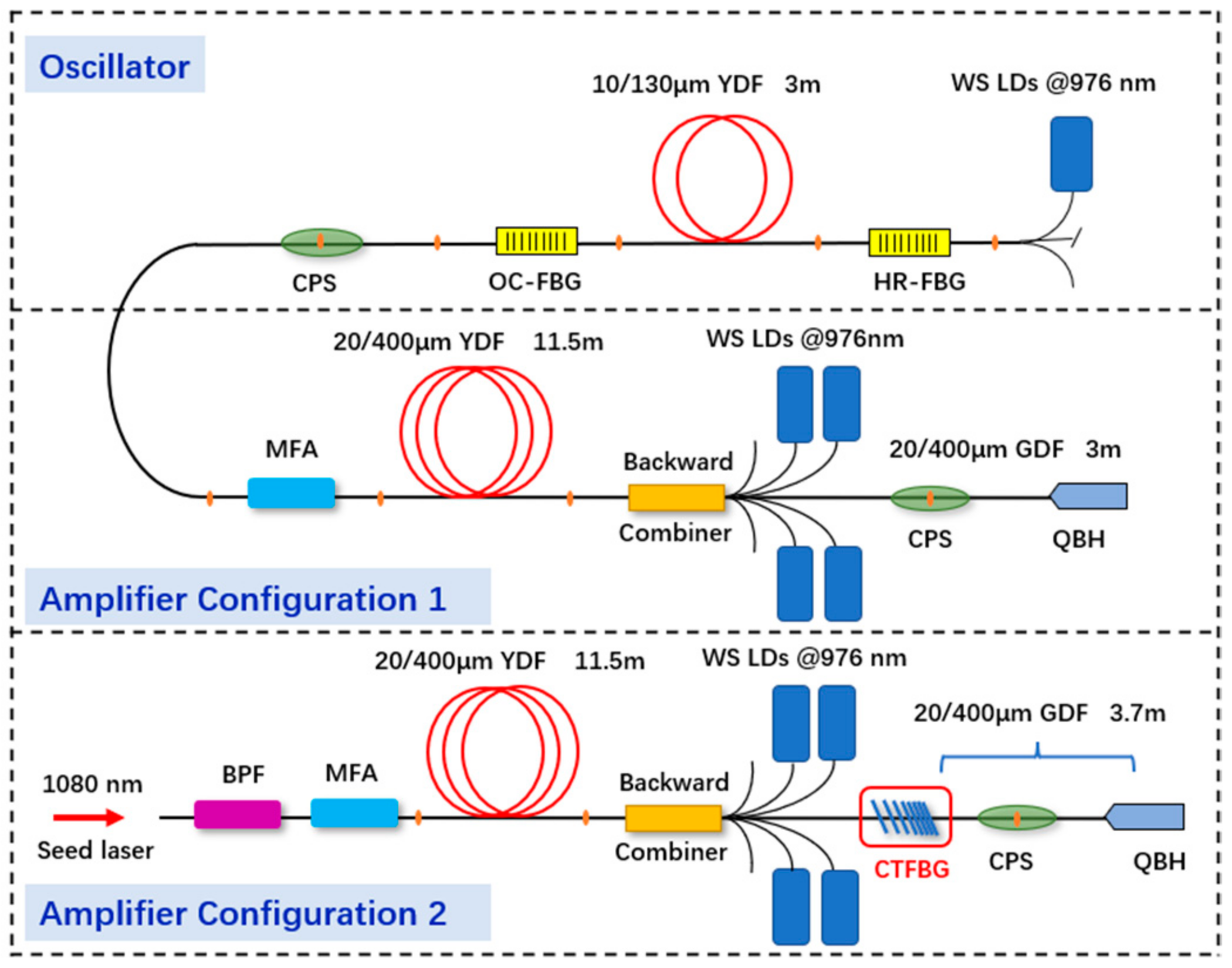
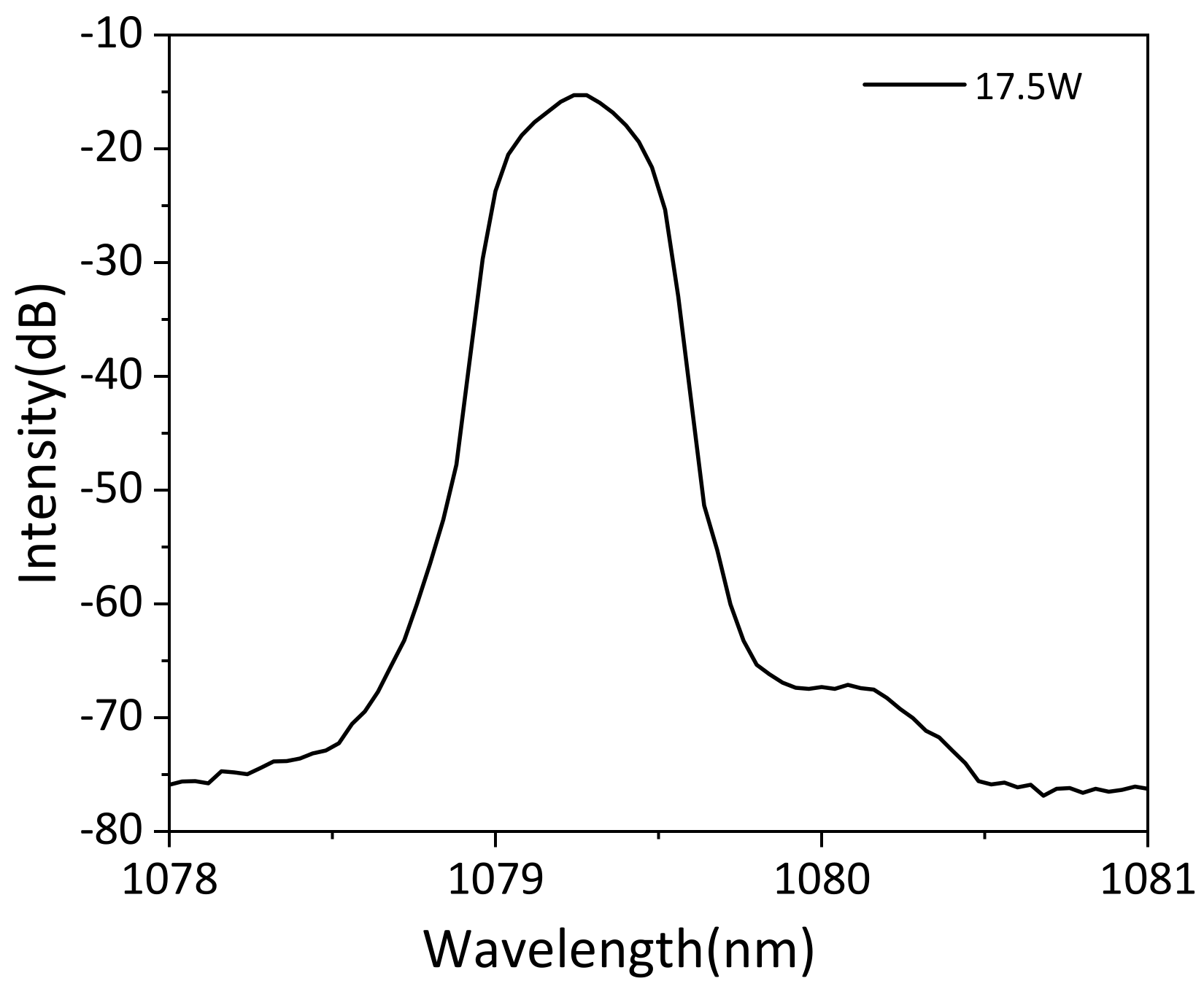
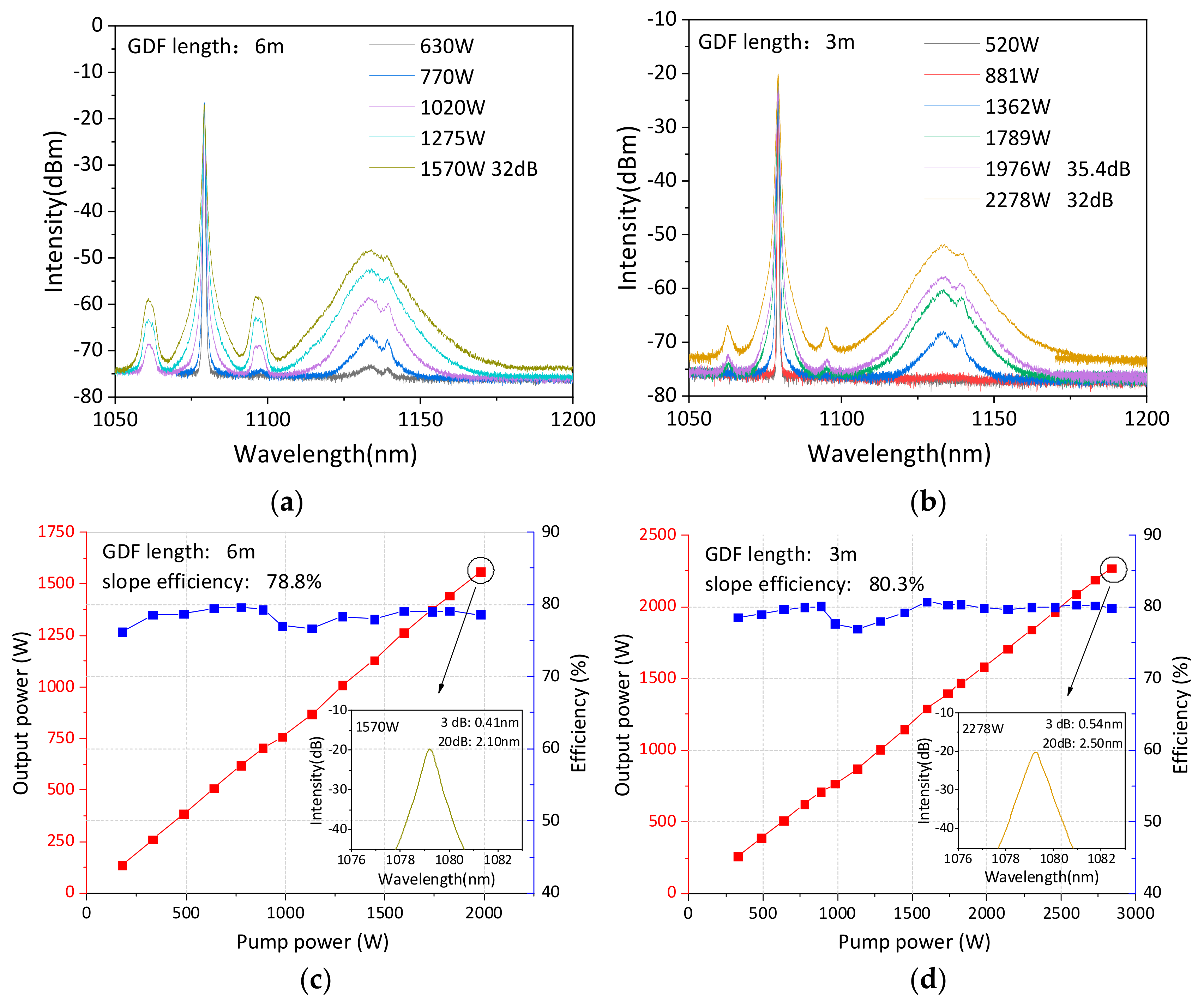
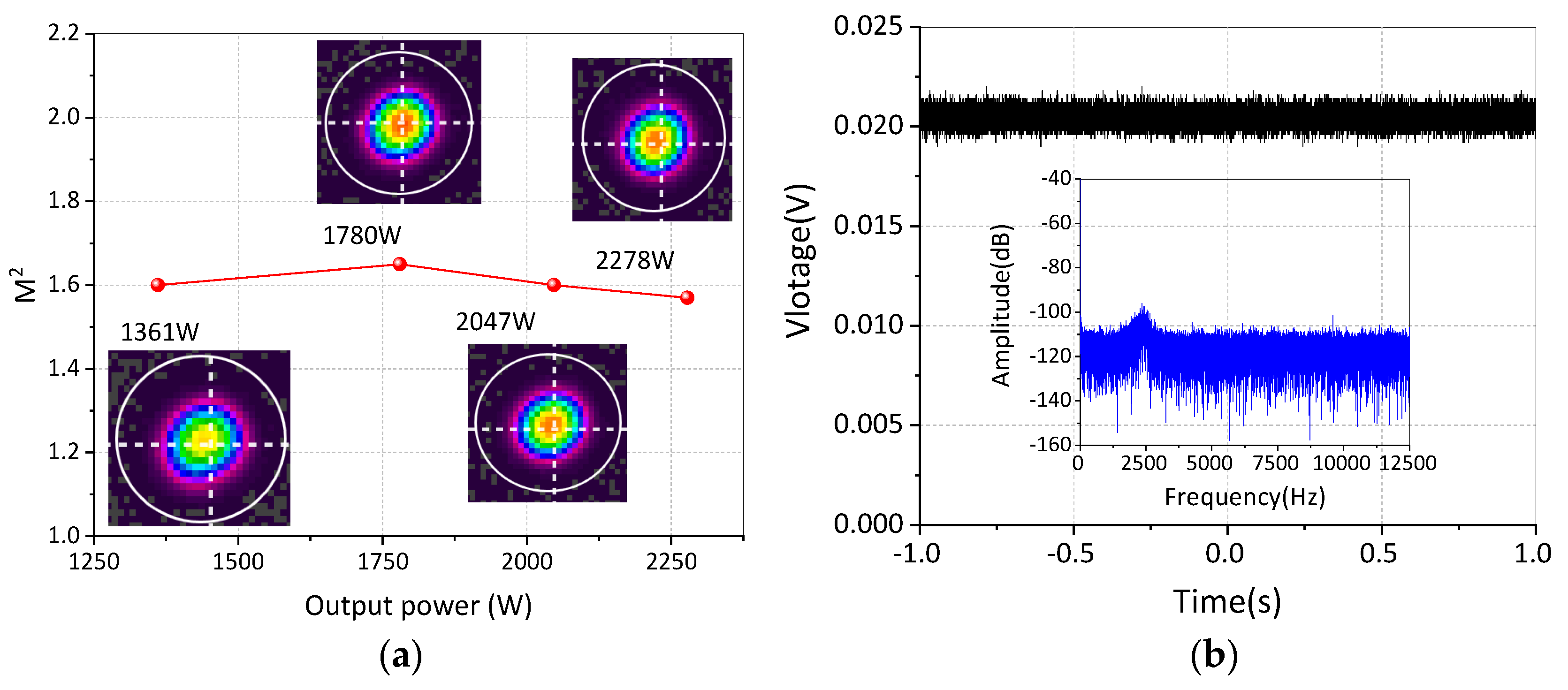
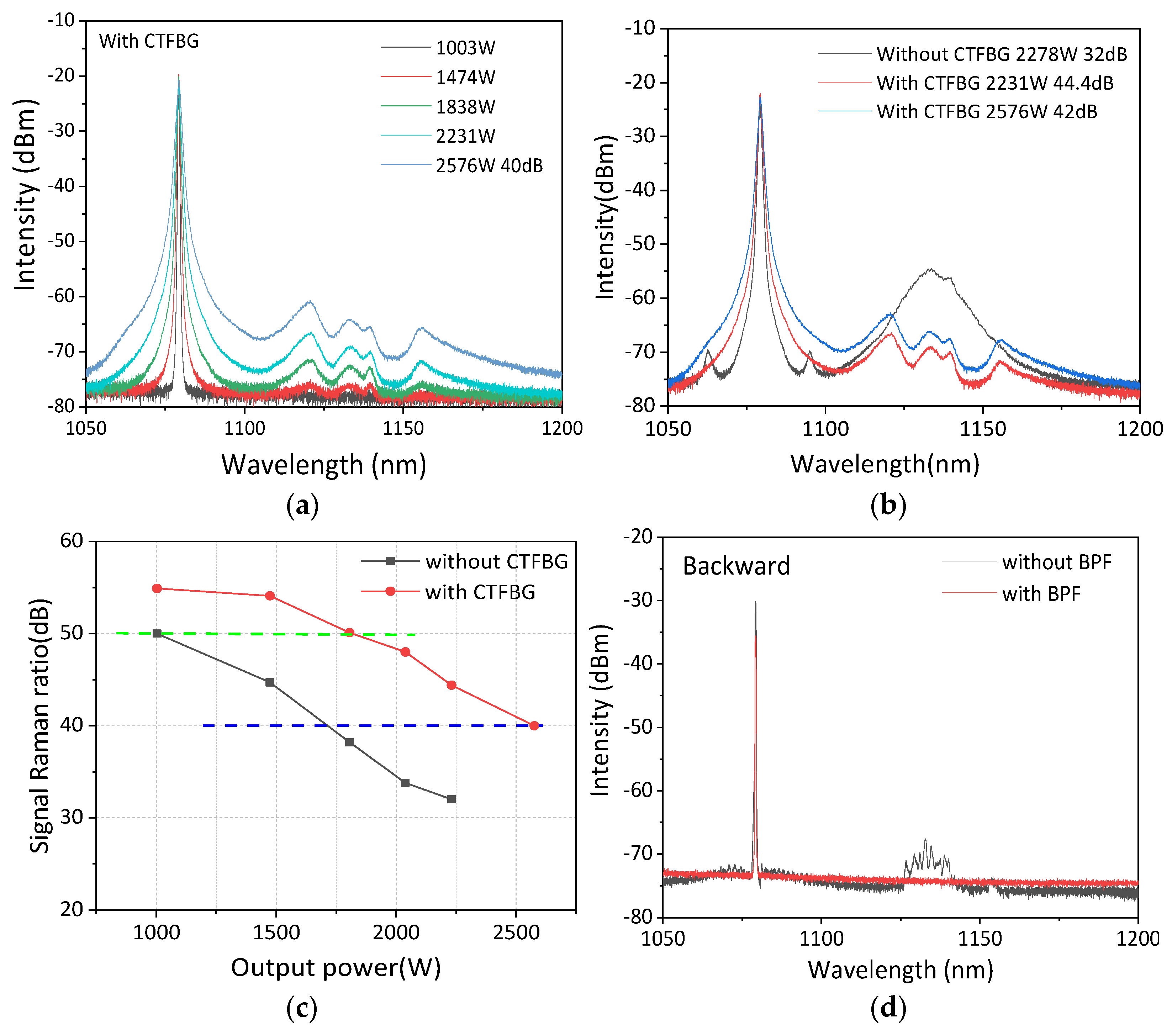
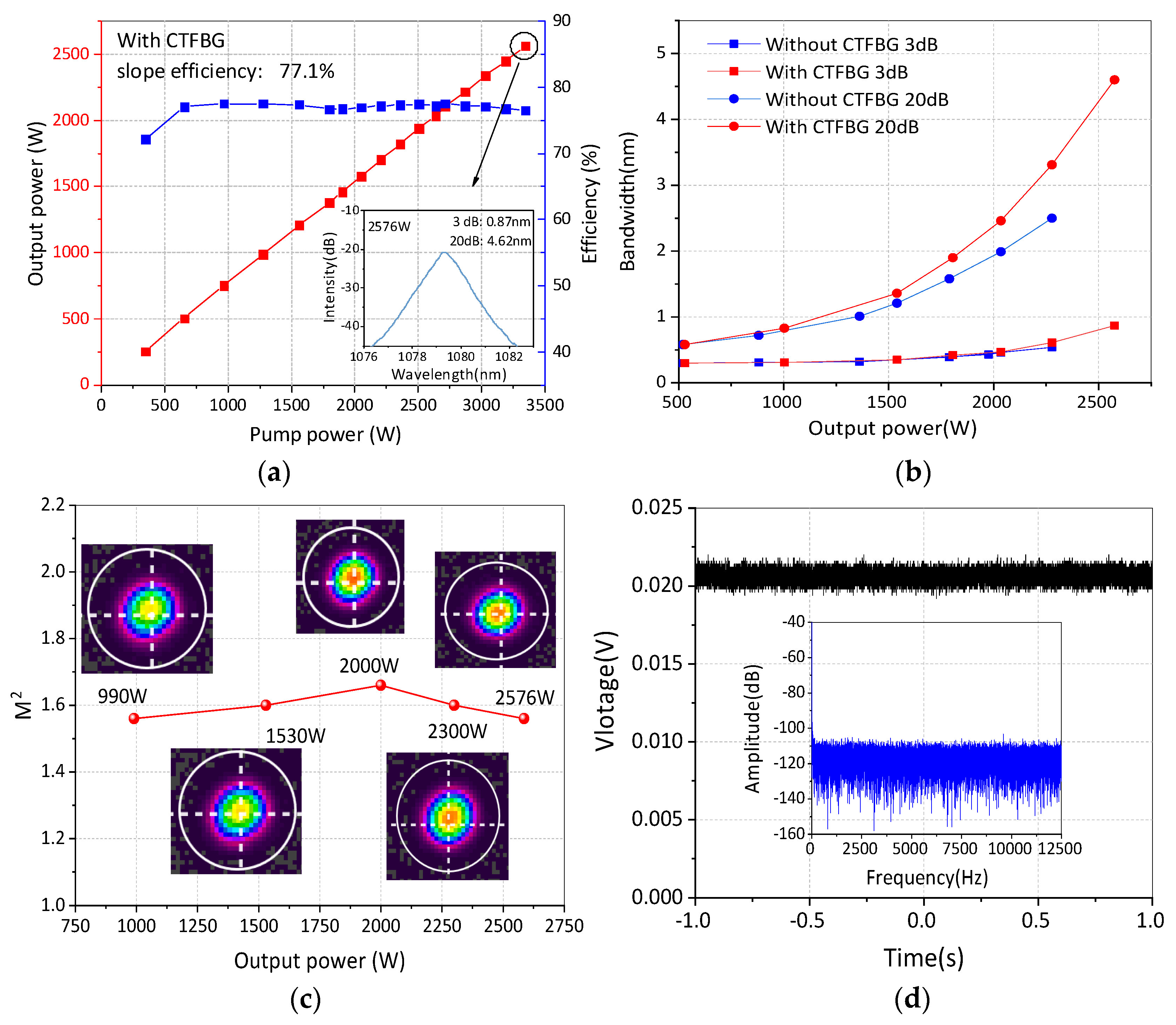
Publisher’s Note: MDPI stays neutral with regard to jurisdictional claims in published maps and institutional affiliations. |
© 2021 by the authors. Licensee MDPI, Basel, Switzerland. This article is an open access article distributed under the terms and conditions of the Creative Commons Attribution (CC BY) license (https://creativecommons.org/licenses/by/4.0/).
Share and Cite
Tian, X.; Gao, C.; Wang, C.; Zhao, X.; Wang, M.; Xi, X.; Wang, Z. 2.58 kW Narrow Linewidth Fiber Laser Based on a Compact Structure with a Chirped and Tilted Fiber Bragg Grating for Raman Suppression. Photonics 2021, 8, 532. https://doi.org/10.3390/photonics8120532
Tian X, Gao C, Wang C, Zhao X, Wang M, Xi X, Wang Z. 2.58 kW Narrow Linewidth Fiber Laser Based on a Compact Structure with a Chirped and Tilted Fiber Bragg Grating for Raman Suppression. Photonics. 2021; 8(12):532. https://doi.org/10.3390/photonics8120532
Chicago/Turabian StyleTian, Xin, Chenhui Gao, Chongwei Wang, Xiaofan Zhao, Meng Wang, Xiaoming Xi, and Zefeng Wang. 2021. "2.58 kW Narrow Linewidth Fiber Laser Based on a Compact Structure with a Chirped and Tilted Fiber Bragg Grating for Raman Suppression" Photonics 8, no. 12: 532. https://doi.org/10.3390/photonics8120532
APA StyleTian, X., Gao, C., Wang, C., Zhao, X., Wang, M., Xi, X., & Wang, Z. (2021). 2.58 kW Narrow Linewidth Fiber Laser Based on a Compact Structure with a Chirped and Tilted Fiber Bragg Grating for Raman Suppression. Photonics, 8(12), 532. https://doi.org/10.3390/photonics8120532



